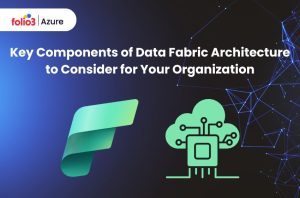Table of Contents
ToggleThe business sector is becoming highly competitive with the rise in consumerism. Maintaining competitiveness and staying ahead in today’s fast-paced business environment has become requisite and requires integrating innovative technological solutions.
Implementing Microsoft Fabric for Business Central ERP can streamline your operations, enhance data synchronization, and boost overall efficiency. This detailed guide will enrich you with best practices and tips for a successful implementation, ensuring that you maximize the benefits of this powerful integration.
Preparing for Implementation
Microsoft Fabric integration involves many pre requisites that must be taken care of , before we step into the implementation phase. Lets acquaint you with the preparatory steps.
1. System Requirements
Before you start initiating the fabric implementation for Business Central ERP, it’s compulsory to understand the system requirements. Make sure that your hardware and software fulfill the necessary requirements for Microsoft Fabric integration. This comprises of having the latest versions of Business Central ERP along with compatible operating systems.
Other than that, you must verify that your servers have adequate storage and processing power to manage the increased load that will arise as a result of the integration.
Microsoft Fabric needs a stable network connection and a well-configured server environment. Before proceeding with the implementation, it’s essential to have a detailed checklist of system requirements and verify that all conditions are fulfilled.
2. Initial Assessments and Planning
Carry out an in-depth analysis of your current system setup to spot any gaps or possible hurdles that might arise during the Business Central ERP setup process. Chalk out a detailed plan that clearly defines each step of the implementation process, from initial configuration to final testing. A risk management plan needs to be part of this planning stage in order to handle unanticipated difficulties.
Important planning steps also include analyzing your current data architecture, interpreting data flows, and determining critical integration points. You should also consider your system’s scalability to ensure it can accommodate future expansion and higher data loads.
3. Assembling an Implementation Team
A fruitful fabric implementation for Business Central ERP needs a skilled and dedicated team. Form a team with clearly defined roles and responsibilities for each member. A project manager, system administrator, data analyst, and technical support personnel are usually included in this. Make sure that every team member is dedicated to the project’s success and is mindful of their particular duty in it.
Involving stakeholders from different departments can provide valuable feed back and information. It also ensures that the system meets your organization’s unique needs. Regular team meetings and clear communication are the key factors leading to effective collaboration and better problem-solving.
Installation of Microsoft Fabric
Now lets move on to the most significant task, which is installing the Microsoft Fabric and exposing your business to its immense benefits.
1. Downloading and Installing Microsoft Fabric
Start by downloading the Microsoft Fabric installation files from the official Microsoft website. Follow the step-by-step guide provided in the documentation to install the software. This process usually consists of running the installer, agreeing to the license terms, and selecting the appropriate installation options.
Make sure that you have the required administrative permissions to install the software. It’s also recommended to perform the installation during off-peak hours to reduce the risk of disruptions to your business operations.
2. Basic Configuration
After successfully installing the software, proceed with the initial configuration of Microsoft Fabric. This includes setting up user accounts, defining security permissions, and configuring basic settings to ensure the system functions smoothly. Proper configuration is a must to avoid potential blockages during the integration process.
Every setting and configuration change made during the configuration process should be documented. This documentation will benefit system audits and troubleshooting in the future. To further secure sensitive data, ensure that all security settings are appropriately enacted.
Integrating Microsoft Fabric with Business Central ERP
Microsoft fabric Integration involves the following key steps, if these are followed carefully, you are in for a rewarding integration of both softwares.
1. Establishing Connections
To establish connections successfully between Microsoft Fabric and Business Central ERP, you must follow the detailed steps listed in the integration guide. These steps consist of configuring network settings, ensuring both systems can communicate easily , and setting up secure connections. Proper connection setup is the key for smooth flow of data between the two systems.
Network configuration should include setting up firewalls, VPNs, and other security measures to protect data during transmission. Connections should also be regularly tested to ensure they are stable and secure.
2. Data Mapping and Transformation
Data mapping and transformation are necessary to guarantee that Microsoft Fabric correctly interprets data from Business Central ERP. To match data fields between the systems, techniques such as transformation scripts and data mapping tools are used. This step is essential for maintaining data consistency and integrity.
Developing a complete data mapping plan, that involves understanding the structure and format of data in both systems. To avoid data mistakes and errors, ensure that data types, formats, and units of measurement are the same across systems.
3. Setting Up Data Synchronization
Configure real-time ERP data synchronization to keep data in synchronized between Microsoft Fabric and Business Central ERP. This includes setting up synchronization plans, defining data synchronization rules, and testing the synchronization process to ensure it is delivering the expected results. Real-time data synchronization helps in keeping information updated across your systems.
Synchronization settings should include conflict resolution rules to handle any discrepancies in data in the two systems. Monitor synchronization logs regularly to identify and resolve any issues.
Best Practices for Implementation
Employ the following best practices to make your integration highly successful and error free.
Planning and Project Management
Effective planning and project management are essential for a fruitful fabric implementation for Business Central ERP. Devise an in-depth project plan that consists of project timelines, milestones, and resource allocation. Regularly review and modify the plan as per need to ensure the project stays at par with the plan.
Project management software can be used to track progress, assign tasks, and promote team communication. Frequent progress reviews and status updates help keep the project on schedule and quickly resolve any problems.
Data Security and Compliance
Ensure that your implementation adheres to industry standards for data security and compliance. Implement robust security measures to protect sensitive data during the integration process. This includes encryption, access controls, and regular security audits.
Data security is a critical aspect of the integration process. Implement multi-factor authentication, data encryption at rest and in transit, and regular security audits to ensure compliance with industry standards and regulations.
Customization and Flexibility
Benefit from the variety of customization options available in Microsoft Fabric to modify the integration according to your unique business needs. Employ flexible configuration settings to alter the system according to your workflows, ensuring a seamless integration that matches with your business processes.
Enhancing the user experience and improving operational efficiency should be the main goals of customization. Assist end users in understanding their needs so that the system may be adjusted to meet them.
Tips for Successful Integration
Here are some valuable pointers to make your integration highly rewarding for your organization.
1. Optimizing Performance
To maximize the performance of your integrated system, regularly monitor system performance indicators and alter the configurations as needed. Implement performance-tuning practices such as indexing, query optimization, and load balancing to ensure the system runs efficiently.
Performance monitoring tools can help identify possible hurdles and areas for improvement. To maintain maximum system performance, regularly review performance metrics and adjust configurations.
2. Common Pitfalls to Avoid
Be mindful of common challenges that can arise during the fabric implementation for Business Central ERP. These may include data integration issues, system compatibility problems, and inadequate training for end-users. Handle these issues proactively to avoid possible setbacks.
Thoroughly evaluate all the parts’ compatibility to ensure they function smoothly together. Provide end users with thorough training and assistance to reduce resistance and guarantee smooth implementation.
3. Continuous Monitoring and Improvement
You must adapt techniques for continuous monitoring and improvement of the integrated system. Regularly review system performance, user feedback, and data accuracy to identify areas for improvement. Make the required adjustments to the system so that it continues to meet your business needs.
Create a continuous improvement approach that consists of system audits, user input sessions, and frequent performance evaluations. By being proactive, problems are found and resolved before they have an impact on company operations.
Testing the Integration
Testing the integration is vital to ensure that all modules are working properly and in harmony without any flaws or hurdles.
Developing Test Scenarios
Create all encompassing test scenarios to ensure the integration works as expected. These scenarios should cover all parts of the integration, including data synchronization, user access, and system performance. Develop test cases that simulate real-world usage to identify possible issues.
Test scenarios must include boundary cases and stress tests to assess the system’s efficiency and trace bugs. Ensure that all possible user interactions and data flows are tested thoroughly.
Conducting Tests
Perform initial and detailed tests to validate the integration. This includes running functional tests, stress tests, and user acceptance tests. In-depth testing ensures the system operates smoothly and meets your business requirements.
Document test results and track any issues that arise. Prioritize and resolve critical issues before going live with the system.
Addressing Issues
Identify and resolve any issues that arise during the testing phase. This may involve debugging code, adjusting configurations, or providing additional user training. Addressing issues promptly ensures a smooth transition to the integrated system.
Implement a quick issue-tracking and resolution process. Regularly inform stakeholders on progress and ensure all critical issues are resolved before deployment.
Conclusion
Implementing Microsoft Fabric for Business Central ERP can immensely improve and boost business operations, providing improved data synchronization and organized workflows. By following the best practices and tips discussed in this guide, you can ensure a successful implementation that meets your business requirements.
For further information on Azure Data Analytics and its integration with Business Central ERP, visit Azure Data Analytics. Let us help you in taking your business to the next level by implementing Microsoft Fabric for Business Central ERP.


